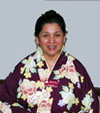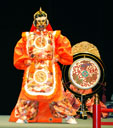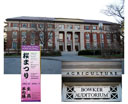April 18, 2008: Amherst
Under the title Sakura Matsuri, the University of Massachusetts at Amherst presented a
Japan Festival of Arts from April 16th to the 19th. Kitanodai Gagaku Kai was invited to participate in the event and
introduced the traditional arts of Japan through their new production,
Furoshiki.
The event took place in the Bowker Auditorium located on campus. The morning show was opened at 10:00 am to 480 children
who attended from a local elementary school. After the show, fifteen students came up to the stage and participated on a
workshop that taught them aspects of the traditional bugaku dance.
The evening presentation of Furoshiki started at 8:00 pm in the same auditorium in front of an audience of 408 people.
Comments of the audience:
"The Tea ceremony part was very good. I was very impressed because there was no ceremonial way of drinking tea in the West.
I was especially moved when I heard the explanation of ichi-go ichi-e."
"The Ryo-oh dance was strong and good." "The Kocho dance was beautiful and very good."
"I was astonished to see the beautiful set up of the stage and the costumes worn by the performers."
 | Greetings by Prof. Ranjanaa Devi, Director of the Asian Arts & Culture Program at U-Mass |
 |
Host Dr. Stephen Forest, Asian Languages & Literatures at U-Mass |
Bugaku "Ryo-o" |
Volunteer students from U-Mass U-Mass Sakura Matsuri PDF File: "Asian arts & Culture" |
Bugaku "Ko-cho" |
Bugaku "Urayasu-no-mai"  |
April19, 2008: South Hadley
On the following day after the performance, a gagaku workshop was held at
the Japanese Weekend School in South Hadley. The program started with the explanation of gagaku by Mr. Miyake whose
children attend the school and was followed by the performances of Etenraku, Ryo-oh, and Kocho. The program ended with a
Q & A session.
Comments by the participants of the workshop:
"I've never seen gagaku before. So I didn't know much about it. I was surprised to see today's authentic performance."
"I felt I should study more about Japanese history. Today's opportunity became a good chance to review the historical
relationship with China and the Korean peninsula."
"I am lucky to see the performance because even in Japan you rarely
have the chance to see it."
"I wish they come back and perform for us on a regular basis." "The costumes and instruments
were unique."
April 16, 2008: Holyoke
As part of the festival, a Tea Ceremony workshop was held at Wisteriahurst Museum in
Holyoke, Massachusetts. Some years before, in 2004, Kitanodai Gagaku Kai also held a tea ceremony workshop titled
Collaboration of Sado and Sho at the Fine Arts Center of the University of Massachusetts.
In addition, bonsai and ikebana workshops were also held on April 14 and 19 respectively.
The Museum, of beautiful Victorian style architecture, was built in the late 19th century as a private mansion and was
donated to the City of Holyoke in 1959.
The tea ceremony was conducted twice and a total of 64 people enjoyed a bowl of tea.
Fore more information, please search The Republican (newspaper report on the tea ceremony,
June 4, 2008).






